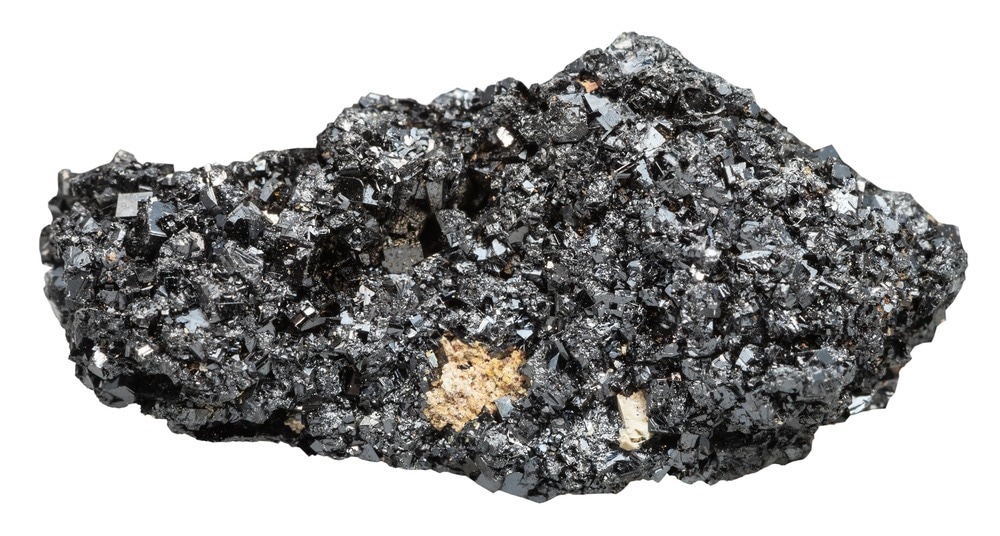Pulsed lasers, a crucial component of the laser industry, are continuously developed to produce higher repetition frequencies and greater intensity. Recently published research findings from the Shanghai Institute of Optics and Fine Mechanics at the Chinese Academy of Sciences exhibit a crystal with promising pulsed laser properties. Research efforts led by the group of Professor Yin Hang and published in Optics & Laser Technology have demonstrated the first laser operation of perovskite oxide LaAlO3 doped with 0.1 at% Nd ions and 0.2 at% Th (Nd,Th:LaAlO3).
 Study: Optical properties of Nd,Th:LaAlO3 demonstrates its potential in high-energy pulsed laser. Image Credit: vvoe/Shutterstock.com
Study: Optical properties of Nd,Th:LaAlO3 demonstrates its potential in high-energy pulsed laser. Image Credit: vvoe/Shutterstock.com
What are Pulsed Lasers?
Pulsed lasers have been used extensively in a variety of research fields. Some examples include:
- Laser micromachining
- Interaction of high-field lasers with materials
- Biomedical engineering
- Optical communications
- Laser nuclear fusion
- Laser imaging
Laser pulses are described by their pulse widths, repetition rates, and pulse energies. Short pulse widths and extremely high peak powers of pulsed lasers have benefited the applications above.
The primary materials in high-energy pulsed lasers are rare earth-doped crystalline materials. The high damage threshold of such bulk crystals is conducive to pulsed laser operation.
Theoretically, a longer fluorescence lifetime will result in a higher repetition rate and more pulsed energy output. The output frequency can also be increased by high thermal conductivity.
Particular characteristics make a crystal an ideal candidate for lasing. These properties are an appropriate emission cross-section, a long fluorescence lifetime, exceptional thermal and mechanical qualities, and the ability to quickly grow to a large size.
While several crystals have been used for pulsed lasers, they have had limited success for high energy emission. For example, due to its greater emission cross section and shorter lifetime, Nd: YAG is less effective than doped crystals such as Nd:LuAG and Nd:glass. Because of their structural features, disordered laser crystals such as Ca3Nb1.5Ga3.5O12 are not typically very thermally conductive and are therefore unsuitable for high-energy applications. New crystals must be discovered to satisfy the demands of repeated frequency high-energy lasers.
Crystal Growth and Laser Operation
Professor Yin Hang's research group used the Czochralski method in an iridium crucible to grow a Nd,Th:LaAlO3. A pure LaAlO3 substrate was used as a seed.
ThO2 powders were added to the melt containing high-purity Al2O3, La2O3, Nd2O3, to achieve doping concentrations of 1 at. % and 0.2 at. %. The crystal was grown for two days before being cooled for 20 hours at room temperature.
From the base product, domain-free crystals of a particular size are cut for laser use. After cutting and polishing, the crystal maintained a single stable domain, and a 3 mm x 3 mm x 4.5 mm crystal with a domain-free laser face was produced. X-ray diffraction analysis and optical microscopy characterized the Nd and Th co-doped LaAlO3 crystal.
In the laser experimental setup, a straightforward plano-concave cavity construction was used. The pump source used was a fiber-coupled laser diode (LD) with a center wavelength of 793 nm. The Nd,Th:LaAlO3 crystal received the pump light after being focused by a fiber output focusing mirror. An optical spectrum analyzer and a power meter were used to measure the laser's output power and spectrum, respectively.
Results and Outlook
Absorption and emission data from the experiment show absorption and emission of the pump light at different NIR wavelengths.
Under 793 nm LD excitation, laser operation was realized. Laser output was obtained at a slope efficiency of 36%, and the corresponding optical-to-optical efficiency was at 34%. Laser output efficiency will increase with coating and greater polishing.
Fluorescence lifetime data were also recorded. Up to 317.7 seconds of fluorescence lifespan with a saturated flux of 5 J/cm2 was measured. Nd,Th:LaAlO3 also has higher thermal qualities than neodymium glass thanks to its high thermal conductivity of up to 10.3 W/mK at 25 °C.
Thorium doping stresses the crystal, immobilizing the domain structure. It then selectively slices the crystal to produce a domain-free crystal that extends in the direction of the dopant.
Overall, LaAlO3 is a promising gain medium for high-energy pulsed lasers. Further development and conditioning of the laser control mechanisms should improve the performance of the beam features.
References
Conghui Huang, Shanming Li, Qiaorui Gong, Qiannan Fang, Min Xu, Siliang Tao, Chengchun Zhao, Yin Hang, Optical properties of Nd,Th:LaAlO3 demonstrates its potential in high-energy pulsed laser, Optics & Laser Technology, Volume 156, 2022, 108495, ISSN 0030-3992. https://www.sciencedirect.com/science/article/pii/S0030399222006478
Disclaimer: The views expressed here are those of the author expressed in their private capacity and do not necessarily represent the views of AZoM.com Limited T/A AZoNetwork the owner and operator of this website. This disclaimer forms part of the Terms and conditions of use of this website.